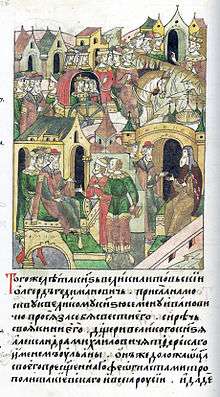Uliana of Tver
| Uliana of Tver | |
|---|---|
 Wedding of Uliana and Algirdas from the Illustrated Chronicle of Ivan the Terrible | |
| Grand Duchess consort of Lithuania | |
| Reign | 1350 – May 1377 |
| Born | c. 1325 |
| Died | 17 March 1391 (aged 65–66) |
| Spouse | Algirdas, Grand Prince of Lithuania |
| Issue | See Family of Algirdas |
| Dynasty |
Rurikid (by birth) Gediminid (by marriage) |
| Father | Alexander of Tver |
| Mother | Anastasia of Halych |
| Religion | Eastern Orthodoxy |
Uliana Alexandrovna of Tver (Russian: Ульяна Александровна Тверская; c. 1325[1] – 17 March 1391)[2] was a daughter of Prince Alexander of Tver and Anastasia of Halych (daughter of Yuri I of Galicia). She was the second wife of Algirdas, Grand Duke of Lithuania.[3]
After her father's and eldest brother's murder by Öz Beg Khan in 1339, Uliana was placed in care of Simeon of Moscow, who married Uliana's elder sister Maria in 1347.[1]
In 1349, Algirdas, Grand Duke of Lithuania, sent an embassy to the Golden Horde, proposing to khan Jani Beg to form an alliance against Prince Simeon of Moscow; this proposal was not accepted and the envoys, including Algirdas' brother Karijotas, were imprisoned and held for ransom.[1] In 1350, Algirdas then concluded peace with Simeon and married Simeon's sister-in-law Uliana. Simeon first asked an opinion of Metropolitan Theognostus whether a Christian lady could be married off to a pagan ruler. The same year, Algirdas' brother Liubartas married Olga, daughter of Konstantin Vasilyevich of Rostov and niece of Simeon.[1]
According to research of Polish historian Jan Tęgowski, Uliana and Algirdas had eight sons and eight daughters (though other sources provide different data).[1] It seems that the children, unlike children from Algirdas' first marriage with Maria of Vitebsk, were brought up in pagan culture.[1] Uliana's son Jogaila (and not Algirdas' eldest son Andrei of Polotsk) inherited the throne and became Grand Duke of Lithuania in 1377. Uliana, as dowager grand duchess, appeared in national politics and was involved in the Lithuanian Civil War (1381–84)[4] as well as an unsuccessful attempt to wed Jogaila with Sophia, daughter of Dmitri Donskoi, and convert him to Eastern Orthodoxy.[5][6] The plans failed when Jogaila converted to Roman Catholicism, married Jadwiga of Poland, and was crowned King of Poland (jure uxoris) in 1386.
There are conflicting claims about Uliana's last years and her burial place. One account claims that Uliana became a nun under the name Marina in the Monastery of the Holy Spirit in Vitebsk and was buried there.[7] Another claim, based on a silver plaque discovered during an 1810 construction, has it that she was buried in the Cathedral of the Theotokos in Vilnius.[8] The Nikon Chronicle recorded that she was an nun at the Kiev Pechersk Lavra and was buried there.[9] The newest discovery was made during a restoration of the Transfiguration Church in Polotsk in March 2012. An inscription was found that recorded Uliana's death on the feast of Saint Alexius, which is March 17 in Eastern Orthodoxy.[2][10]
See also
- Family of Algirdas – family of Uliana and Algirdas
References
- 1 2 3 4 5 6 Baronas, Darius (2013-04-07). "LDK istorija: Algirdo antroji žmona Julijona – savo valandos sulaukusi našlė". Savaitraštis „15min“. ISSN 1822-5330. Retrieved 2013-04-19.
- 1 2 Калечиц, Инна Л. (2013-03-21). "Исторические личности в граффити Полоцкой Спасо-Преображенской церкви" (PDF). Музеефикация комплекса настенной живописи ХІІ-ХІХ вв. Спасо-Преображенского храма Евфросиньева монастыря в Полоцке. Balarusian Republic Foundation for Fundamental Research. pp. 6–7. Retrieved 2013-04-29.
- ↑ Mažeika, Rasa (1987). "Was Grand Prince Algirdas a Greek Orthodox Christian?". Lituanus. 33 (4). ISSN 0024-5089. Retrieved 2007-09-06.
- ↑ Koncius, Joseph B. (1964). Vytautas the Great, Grand Duke of Lithuania. Miami: Franklin Press. pp. 21–23. LCC 66089704.
- ↑ Gieysztor, Aleksander (1998). "The kingdom of Poland and the grand duchy of Lithuania, 1370–1506". The New Cambridge Medieval History, c.1415–c.1500. 7. Cambridge University Press. p. 731. ISBN 0-521-38296-3.
- ↑ Kiaupa, Zigmantas; Jūratė Kiaupienė; Albinas Kunevičius (2000) [1995]. The History of Lithuania Before 1795 (English ed.). Vilnius: Lithuanian Institute of History. pp. 127–128. ISBN 9986-810-13-2.
- ↑ "Свято-Духов женский монастырь". Vitebsk Diocese. Retrieved 2013-04-19.
- ↑ Narbutt, Teodor (2001). Lietuvių tautos istorija. 5. Mintis. p. 427. ISBN 9785417008269.
- ↑ Sergey Platonov, ed. (1897). VIII. Летописный сборник, именуемый Патриаршею или Никоновскою летописью. Complete Collection of Russian Chronicles. 11. p. 127.
- ↑ "Расшифровка надписей в Спасо-Преображенском храме". Novopolock.ru. Retrieved 2013-04-29.